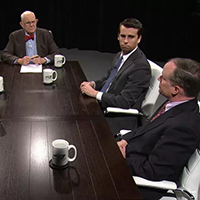NC should not abandon its commitment to individualized education
Published June 11, 2015
by Matt Ellinwood, NC Policy Watch, June 11, 2015.
Earlier this month, Governor McCrory signed legislation that ends the practice of providing Personal Education Plans (PEPs) to students who are at risk of academic failure. Though probably an unavoidable step given the flawed and sporadic use and implementation of PEPs, the decision raises real questions about the future of individualized learning plans in North Carolina and whether the state will settle for a “one-size-fits-all” approach.
PEPs were created in 2001 in response to concerns that not enough was being done to help at-risk students who fail to progress at grade level with their peers.
The PEP law required districts to identify students who are at risk of academic failure, provide them with evidence-based instructional supports and involve parents in crafting individualized learning plans designed to help students get on track. The law listed examples of learning supports that students should receive like tutoring, mentoring, coaching, extended days, summer school, or Saturday school and stated that transportation should be provided free of charge.
Unfortunately, despite the good intentions of the law, no funding was ever appropriated to provide students with these supports. On the contrary, since 2008, there have been massive state funding reductions for essential educational supports like teachers (3.5%), teacher assistants (22.9%), instructional supplies (51.9%), and textbooks (78.1%); funding for mentoring, staff professional development, and literacy coaches has been eliminated entirely.
It is no wonder therefore that teachers had mixed feelings about PEPs. The law essentially required them to identify students who are at-risk, meet with parents to come up with an individualized learning plan, and then inform the parents that none of the supports their at-risk child ought to receive are available at the school due to lack of funding.
There were also major problems with the way the law was implemented. Many parents, teachers, and even school district officials remained completely unaware of the requirement to create PEPs for at-risk students. Many of those who were aware saw PEPs as just another useless form in an avalanche of paperwork that was automatically generated at the end of the school year after it was too late to do much good.
The law also required districts to collect and submit data on PEPs, but that never happened either so there is no way to know which districts were complying with the requirement and no data on whether or where PEPs were having a positive impact on student achievement.
All of this helps explain why the PEP law was repealed, but not what comes next. Under the new law, students at risk of academic failure still have to be identified, but there will no longer be a requirement to develop a plan that includes individualized educational services to help them overcome that risk. Instead, schools will simply develop transition plans for large groups of students.
This is a problem.
Flawed as the old law was, some parents were able to use PEPs to effectively advocate for their child because it gave them the right to meet with their child’s teacher and provide ongoing input regarding their child’s individualized learning goals and needed instructional supports. It also put the state on record as having a commitment to individualized learning. Now, those parents will no longer be able to point to a state statute when advocating for their at-risk children.
The bottom line: While schools have had little choice but to move away from individualized instruction in the current climate of chronic underfunding because they simply cannot afford an array of services tailored to each student’s needs, this should not be the end of the story.
Individualized learning plans have improved student achievement in states like Vermont when implemented with fidelity and funding. Similarly, federally-required Individualized Education Plans (IEPs) for students with disabilities uplifted an entire generation of formerly neglected students. And, of course, PEPs have worked for many in North Carolina and remain a voluntary option for teachers for whom they’ve worked well. Intuitively, a student who has been identified as persistently struggling will need additional supports or a new educational plan that fits his or her needs better than the standard instructional model that has already been tried and found wanting.
Thankfully, there remains cause for optimism. The new law directs the State Board of Education to report on how at-risk students are being identified and served across the state. This is an opportunity to get it right on individualized learning going forward and replace PEPs with meaningful individualized learning plans that reflect the services that are available to at-risk students and engage parents. We cannot expect teachers to help their students meet higher proficiency standards without additional supports that address students’ needs. PEPs had their problems, but going forward North Carolina must do more to help at risk students succeed in school.
June 11, 2015 at 10:55 am
Richard L Bunce says:
Oh the hypocrisy of NC Policy Watch... there is no more individual education plan than Education Vouchers where parents select the best education system for their children.







